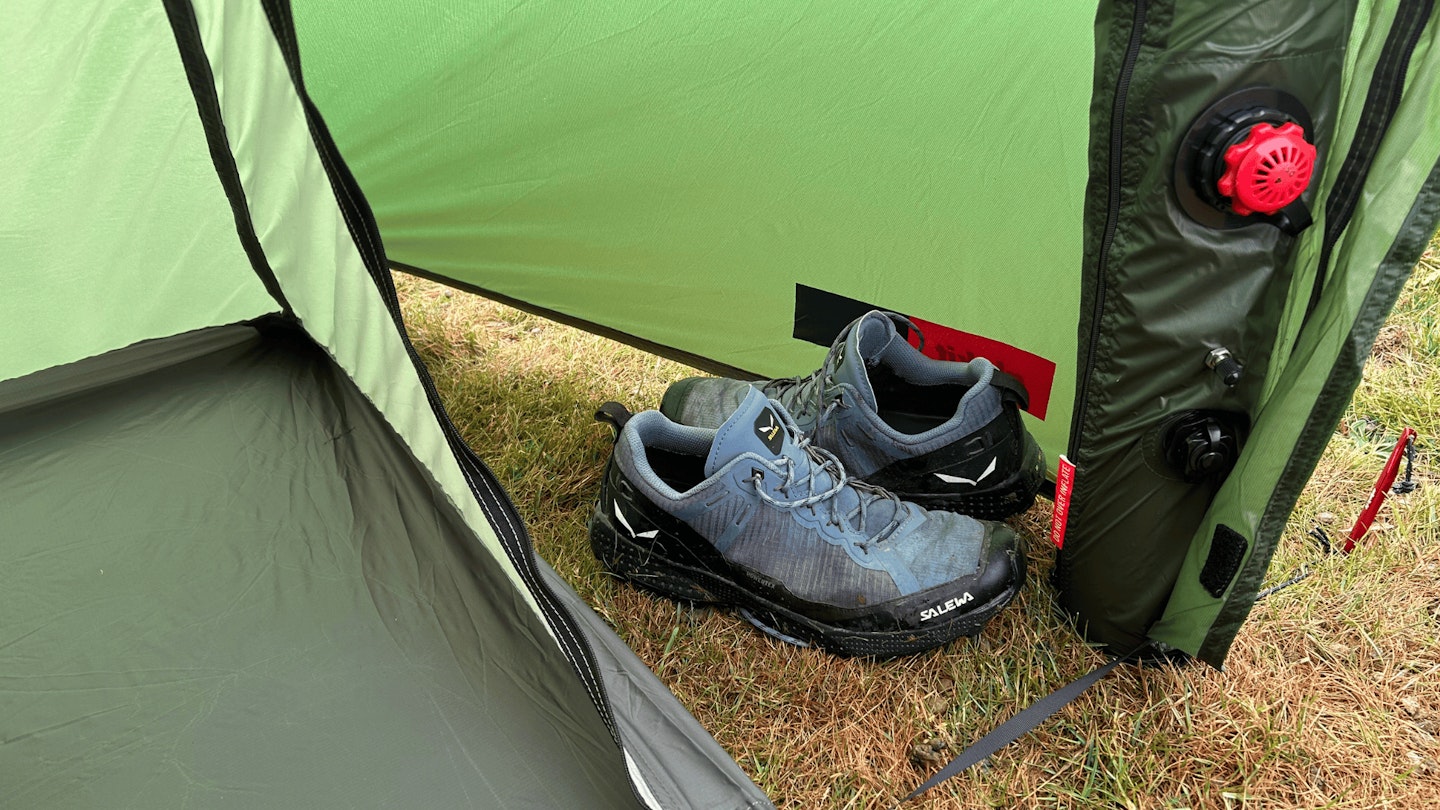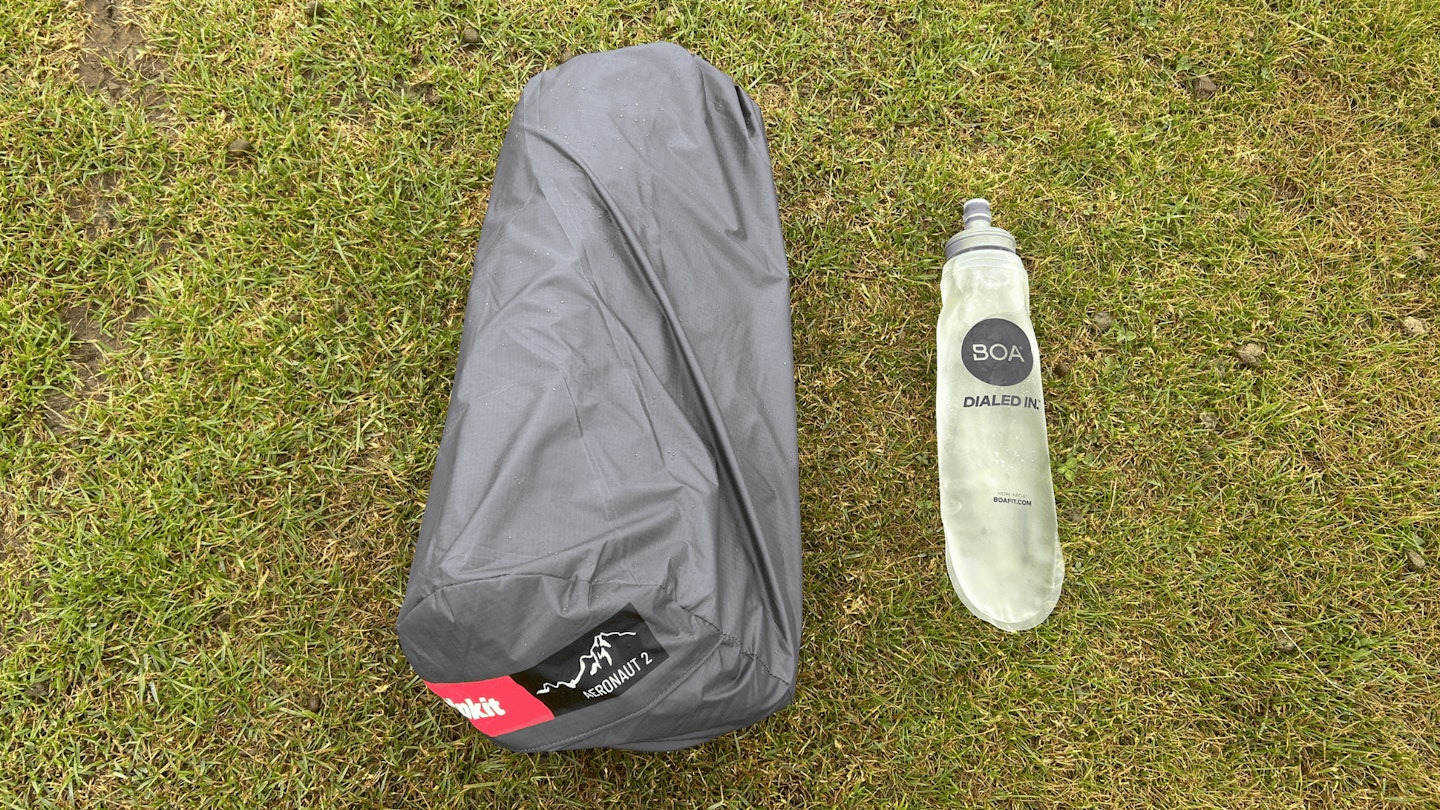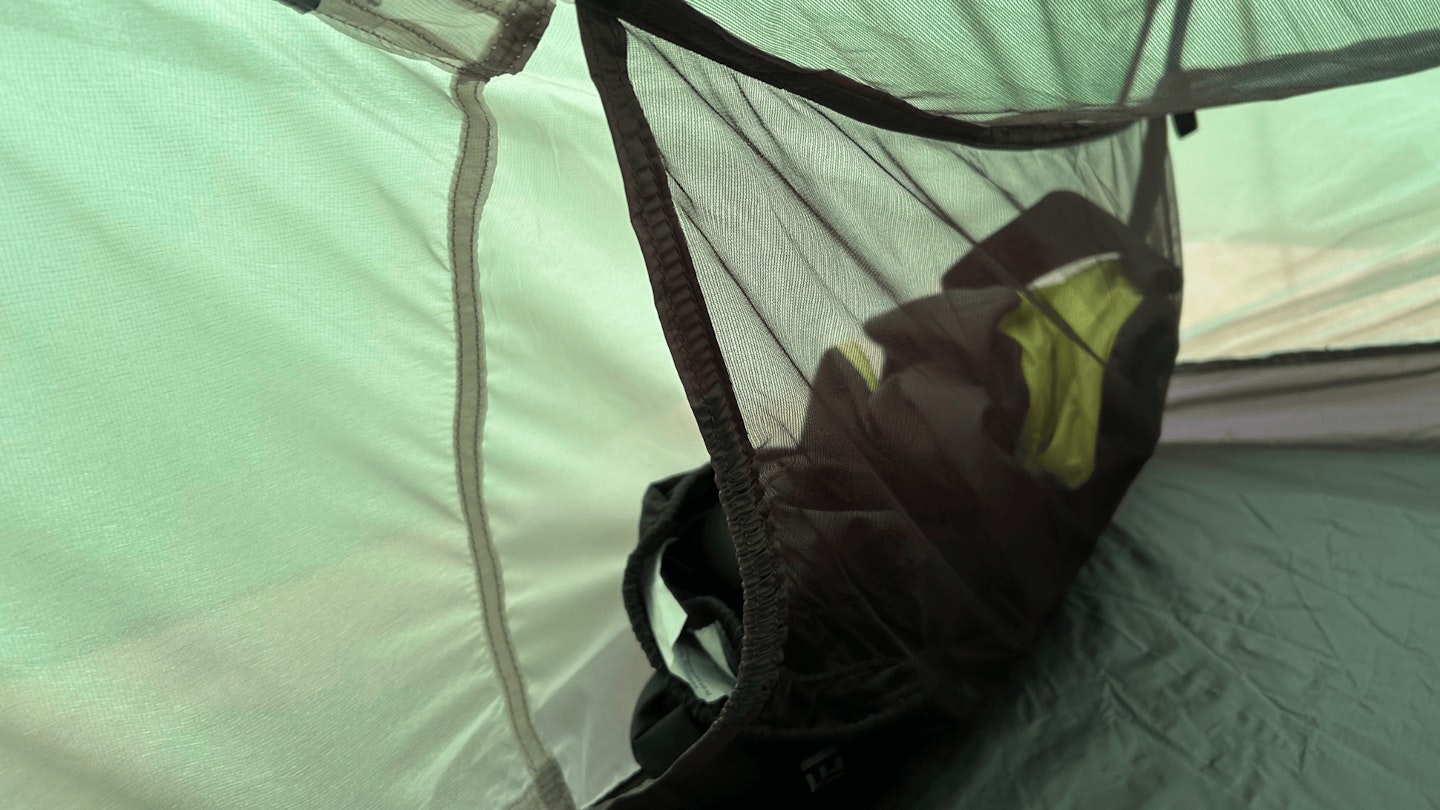Air tents are usually associated with large family shelters – great fortresses of fabric that spring into life in minutes, provide palatial living spaces and take up half the campsite’s footprint. This is not the case with the Aeronaut 2, an inflatable tent designed with wilder activities like backpacking, bikepacking and kayaking expeditions in mind.
It’s a classic, lightweight backpacking tunnel tent that uses a hooped arch to raise the headspace at one end. The difference being that the arch is an air beam, rather than a pole threaded through the tent’s sleeves, which makes the tent easy to squeeze into a compact pack for easy transportation.
In terms of size, it’s fine for catching some shut-eye at the end of an adventurous day on the trails, but there are much more spacious and liveable two-person tents out there for car camping. Nevertheless, if you’re looking for great a three-season wild camping shelter, this is where to find it.
For such a lightweight tent, it’s waterproof credentials are solid, especially when compared to many of the popular American backpacking models doing the rounds. Read on for our detailed test and review.
Pros
- No poles to faff with
- Can be inflated with a bike pump
- Plenty of internal storage and hanging points
Cons
- Not as liveable as some
- Porch isn't the largest
- Pegs bend easily
| RRP: | £199.99 / $279.99 |
| Weight: | 1.5kg / 3lbs 5oz |
| Packed size: | 39 x 19 x 14cm |
| Internal dimensions: | 250 x 200cm |
| Internal peak height: | 105cm |
Shape, structure, pitching and internal liveability

The Aeronaut 2 has a single hooped tunnel shape – tall at one end and with a hooped arch and a raised footbox at the other. Its structure is broadly similar to popular models like Terra Nova’s Zephyros Compact 2, Vango’s F10 Helium UL 1 and many others besides.
The reason behind this structure’s enduring appeal is that it makes for a quick and easy tent to pitch, while providing a stable shelter that can cope with a wide range of weather.
The single air beam forms the hooped arch, while two footbox poles hold up the bottom of the tent. The air beam can be inflated by either a bike pump or a foot pump. By not including a pump, Alpkit have saved weight and the fact it works with a bike pump is a great innovation where bikepackers are concerned.
I just hope nobody has ever taken it up somewhere breathlessly remote without a pump before realising.

The tent pitches with the inner and outer already in unison for a fuss-free setup. The air beam inflates in a matter of moments and I found it just needed a little nudge to spring into its arch shape. The little footbox poles slotted into their eyelets effortlessly and, all of a sudden, I had a workable tent.
All that was left was to peg out the guylines. Unfortunately, by the end of the test period I had three bent pegs. I get that brand’s have a balance to be strike between low weight and robust heft but I was a bit disappointed at how easily these pegs can deform during pitching.
When it came to the get out, I simply pulled the plug on the valve and the air beam deflated in an instant. It makes packing down super speedy – I timed it at four minutes – and the fact that there are only the two footbox poles means that squashing the tent into the stuff sack is easy enough.

It should come as no surprise to anyone who’s camped in a single hooped tunnel tent that the interior isn’t exactly a liveable space. It’s designed for sleeping and stashing gear, not for enjoying a semi-alfresco feta and olive salad feast (or something a little less flamboyant). There’s room to sit up and faff around with gear at the hooped end, but that’s about it.
The ceiling here is around 95cm tall at its apex, while the living space is 238cm long, 150cm at its widest, and 92cm wide at the foot end. This makes it cosy for two but relatively spacious for a single camper, which is how I imagine most will use the tent anyway.
Alpkit states that the beam’s arch creates a wider internal space that also allows for a small porch at the entrance, ideal for stashing dripping wet walking boots and the like. It’s not the biggest porch – I found it was fine for my shoes but there wouldn’t be much room for a dripping wet backpacking rucksack.
Waterproofing

The Aeronaut’s flysheet and groundsheet both employ ripstop nylon enhanced with a polyurethane coating to achieve a durable and waterproof shell. In the case of the flysheet, you get a 15D denier nylon, which puts its ruggedness in the same league as something like Sea to Summit’s Alto TR2.
This light yet strong fabric makes it ideal for three-season wild camping adventures, though it’s not tough enough for winter use.
The PU backer elevates the fabric’s waterproof credentials – Alpkit states a hydrostatic head (HH) rating of 3,000mm. This is very impressive, providing a better shield than many three-season tents, especially ones crafted in America by brands that don’t appreciate quite how much of the Atlantic falls on our often-soggy hills.
Alpkit, being a British brand, has cut no corners here. As you’d expect, all seams are taped, providing waterproof reinforcements at these potential lines of weakness. There’s an additional footprint available for extra groundsheet protection.
The Aeronaut 2 kept me dry while camping through some relatively wet nights in South Wales. The flysheet and groundsheet both performed their role without fuss.
If water was to invade the inner sanctum, it was usually down to other issues – such as that the main door is so low I’d invariably snag it and cause a sudden cascade down my back, or that the porch is so small that I’d invariably have to bring some wet items into the inner. These issues aren’t unique to the Aeronaut 2 though, as most tents of this style have similar.
Condensation

As with Man United fans these days, it’s important for backpacking tents to have the opportunity to vent, otherwise there’ll be trouble. The last thing you want is condensation dripping on your face in the small hours of the night.
Alpkit has combatted this by ensuring the inner tent is largely made of mesh, allowing relatively unimpeded airflow. The outer has a little triangular vent, which works with the fact that air can also get in underneath to create a nicely airy space. I found condensation simply wasn’t an issue during my forays.
Wind protection

It’s natural to have concerns about high winds, especially if you’re not used to wild camping with an air tent. But here’s the thing, where a strong gust might snap an alloy tent pole, it’ll simply bend an air beam.
The good news is, once the gust subsides, it’ll then spring back into shape – provided you’ve pumped it up to the required pressure. If not, you might have to get that waterproof jacket on and get out there armed with a pump.
Of course, this is an extreme example. I found that, with the guylines tensioned and everything pegged out properly, the Aeronaut 2 remained stable during my camping adventures in the windy hills above Abergavenny.
The structure’s ability to shed wind is one of the reasons these hooped tunnel tents are so popular for wild camping use.
Weight and packed size

Air weighs less than fibreglass, hence why tent poles don’t float away like helium balloons. This is why a backpacking inflatable tent has the potential to be lighter than an equivalent shelter than employs traditional poles.
The Aeronaut 2 weighs in at 1.5kg in total – pretty decent for a three-season, two-person backpacking tent, putting it in the same league as the likes of the Sea to Summit Alto TR2 Plus and the MSR Hubba Hubba NX 2.
Alpkit states a packed size of 32 x 15cm on its website, but I found this was wildly inaccurate. I measured the pack at 39 x 19 x 14 (L x W x H). Despite this inconsistency, it’s still a small pack for a two-person tent and I like the fact it’s relatively long and thin, making it easy to slide into a backpack.
For those who like their packing to be the bike – rather than back – variety, it’ll also slot neatly into a saddle bag (alternatively, see our list of the best bikepacking tents).
Features

For your headlamp, phone, keys, Harvey maps and whatever else you want to keep off the ground, Alpkit has included gear compartments. There’s a small gear loft above the head end, two little compartments on the opposite side to the door, and there’s a larger side access compartment by the inner door, too.
This last one is ideal for stashing your sleeping bag and sleeping pad sacks, and it can also be used to house the inner door – very handy. There are also a trio of hanging loops too, so you can shed lantern light on the situation as you plot the next day’s traverse on the aforementioned Harvey map (other maps are available).

On those gloriously sunny days in the hills, the sort where you want to sit in the entrance and enjoy a piping hot coffee while letting your eyes galivant along distant ridge lines, you can stow the tent door away in a mesh pocket by the footbox. This is a nice little touch that makes stashing the door away quick and easy.
The main door features YKK zippers and is the low-down sort that you have to inelegantly dive into. The fact that there’s only one entrance and exit isn’t ideal for two if the camper sleeping on the wall side needs to pop out in the night for a call of nature, or if they receive a text saying that the Aurora Borealis has made a sudden appearance. In the case of the latter, my guess is that they’d wake their mate up anyway though.
Final verdict

The Aeronaut 2 is an innovative little air tent that’s ideal for three-season backpacking or bikepacking. The fact its air beam can be inflated with a bike pump is a very neat touch and in terms of liveability, it’s pretty much what you’d expect from a single hoop tunnel tent.
If you’re after spacious comfort, perhaps look at our best three-person tents roundup, but for a lightweight and well-featured shelter for the trails, it represents good value. Overall, we'd rate it at a solid 80% approval rating.
Shop this product
About the author

As a qualified Mountain Leader, avid wild camper and a family man, Alex Foxfield enjoys camping in all its forms. An expert on all things outdoor gear, he’s been testing and reviewing camping kit and tents – from solo backpacking shelters to palatial family car camping tents – for many years.







